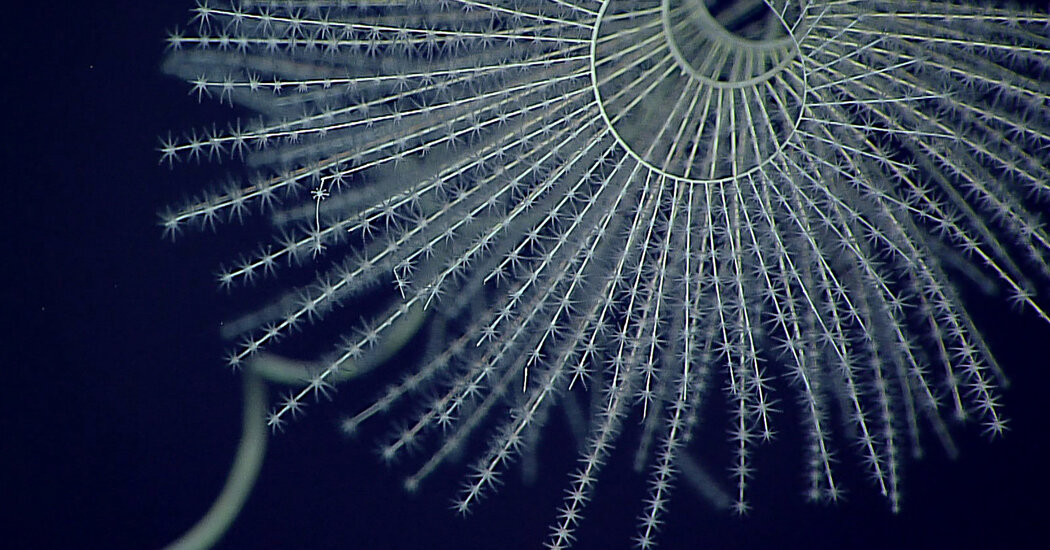Bioluminescence is used throughout the animal kingdom, particularly in marine environments, to lure prey, startle predators and even act as camouflage in the surrounding light.
“We always say it’s light-limited in the deep sea, but there are a lot of organisms that produce their own light,” said Andrea Quattrini, a zoologist at the Smithsonian National Museum of Natural History in Washington.
The dazzling glow of bioluminescence is common in Octocorallia, also known as octocorals, a class of over 3,000 Anthozoa species including sea fans, sea pens and soft corals. The prevalence of bioluminescence in these sessile animals makes a lot of sense, Dr. Quattrini said: “They settle somewhere and they’re there.”
How long organisms have been able to emit light is at the center of recent research by Dr. Quattrini and colleagues. Their latest study, published Tuesday in the journal Proceedings of the Royal Society B, resets the timing for the emergence of bioluminescence back to about 540 million years ago, from the existing understanding that it appeared in small marine crustaceans 267 million years ago.
The researchers based their finding on recent octocoral evolutionary tree work, octocoral fossils and modeling to trace the ancestral past of the tiny organisms.
Bioluminescence is believed to have evolved nearly 100 times across history, caused by a simple chemical reaction, when a light-producing molecule called a luciferin reacts with an enzyme called luciferase.
“This ability to bioluminesce is giving these animals some type of survival or fitness advantage,” said Danielle DeLeo, the lead author on the study and a biologist affiliated with Florida International University and the Smithsonian National Museum of Natural History.
Dr. DeLeo was first captivated by the remarkable glow over a decade ago, while studying the impact of the 2010 Deepwater Horizon oil spill on deep sea communities. Descending a thousand meters below the surface in a submersible, she recalled, “you look out the window and all you see is bioluminescence.”
Now she studies bioluminescence in a range of invertebrates — including deep sea shrimp that spew bioluminescent vomit — and for years has been interested in when this basic yet stunning form of communication first emerged.
Setting the stage to answer that question, in 2022, Dr. Quattrini and her former adviser, Catherine McFadden at Harvey Mudd College in California, who is also an author on the new study, revised the octocoral tree of life based on new genetic data.
In the new study, the researchers incorporated dated octocoral fossils to determine when branches on the tree diverged.
They then collected data on the presence or absence of bioluminescence in as many of those species as possible, pulling from previous research as well as their continuing work. From there, they used a series of statistical models to work back in time, over hundreds of millions of years, to calculate the probability of bioluminescence for each common ancestor on the tree.
Every iteration of the analysis landed them at the same conclusion: that bioluminescence first popped up in the common ancestor of octocorals approximately 540 million years ago, around the beginning of the Cambrian era.
This was just before or at the start of the Cambrian explosion, when a huge number of new, more complex species arose.
“Light-sensing had already evolved by then,” but not quite in the form of eyes, said Elena Bollati, a marine biologist at the University of Copenhagen who was not involved in the study. “Predators weren’t really common before the Cambrian explosion either,” she added, “so this has interesting implications regarding the original function of bioluminescence.”
This work lends support to a longstanding theory that — because the chemical reaction underlying bioluminescence uses up oxygen — bioluminescence first evolved as a defense mechanism against the production of dangerous oxygen-containing molecules called free radicals. Glowing may have just been a byproduct but, as it turned out, a useful one.
“You can take care of oxygen and you can make light and you can perhaps deter predators or attract prey, and then you’re going to be successful into future generations,” Dr. Quattrini said.
Now the researchers are focused on a genetic test that, using just a small piece of tissue, will assess if an animal’s luciferase enzyme is functional, an indicator that it can bioluminesce. This technique will remove the need to collect an entire octocoral colony to physically test if it glows, said Dr. DeLeo, helping protect these creatures from the potential threats of oil drilling, fishing and other anthropogenic hazards.
